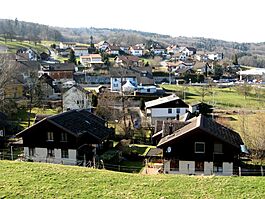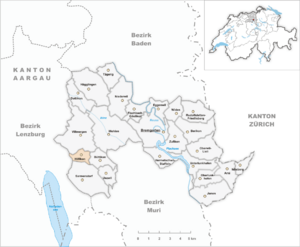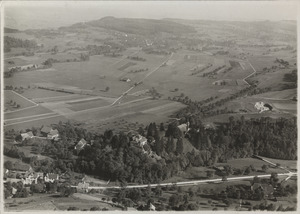Hilfikon facts for kids
Quick facts for kids
Hilfikon
|
||
|---|---|---|
 |
||
|
||
| Country | Switzerland | |
| Canton | Aargau | |
| District | Bremgarten | |
| Area | ||
| • Total | 1.72 km2 (0.66 sq mi) | |
| Elevation | 479 m (1,572 ft) | |
| Population
(December 2020)
|
||
| • Total | 259 | |
| • Density | 150.6/km2 (390.0/sq mi) | |
| Postal code |
5613
|
|
| Surrounded by | Büttikon, Sarmenstorf, Seengen, Villmergen | |
Hilfikon was a small town in Switzerland, located in the canton of Aargau. It used to be its own municipality, which is like a small local government area. In January 2010, Hilfikon joined with a nearby town called Villmergen.
Contents
Hilfikon's Past: A Look at Its History
Hilfikon was first mentioned in old records in the year 924. Back then, it was called Hilfiniswilare. Later, in 1250, its name changed to Hilfinchon.
In 1290, two people named Markwart and Arnold von Hilfikon built a tower house in the area. This was a strong building, often used for defense. The land controlled by the Hilfikon family was first written about in 1415.
Over the years, Hilfikon changed owners many times.
- By 1472, the Meiss family from Zurich owned it.
- In 1498, it became a fief, which means it was land given to someone in exchange for loyalty or service. Hans von Seengen received it.
- From 1506 to 1510, Melchior von Gilgen from Lucerne owned Hilfikon. He also bought the Bailiwick of Sarmenstorf in 1514. A bailiwick was an area ruled by a bailiff, who was like a local governor.
- In 1510, Melchior von Gilgen also helped build a chapel in Hilfikon.
Later, in 1628, John Lussi bought the property. He was a "Landamman" for Unterwalden, which was a leader in that region. Then, in 1644, the Zwyer family took ownership.
In 1743, the village passed to the Tschudi family through marriage. However, in 1749, Augustin Victor Franz Roll from Solothurn took control. He had the old chapel, which was built in a Gothic style, taken down. He then built a new chapel. The new chapel's choir (the part where the singers sit) was made to look like the Church of the Holy Sepulchre.
Hilfikon has always been part of the Villmergen parish for religious matters. A parish is like a church district. In 1743, some parts of the village were under the courts of Villmergen, while other parts were still under the courts of the nobles. In 1798, Augustine von Roll ended this split in legal power, making things simpler.
During the second Toggenburg War in 1712, the castle in Hilfikon was used by the Catholic General Staff. In 1832, the castle was sold and has had many different owners since then.
For most of the 20th century, Hilfikon was mainly a farming town with a few small businesses. In 1916, a railway line was built, and Hilfikon even had its own station. The village also has a school for younger children.
Finally, in 2010, Hilfikon officially joined with Villmergen.
Hilfikon's Location and Land Use
Hilfikon covers an area of about 1.7 square kilometers (about 0.65 square miles).
- A large part of this land, about 63.6%, is used for farming.
- About 25.4% of the land is covered by forests.
- The remaining 10.4% is where buildings and roads are located.
- A very small part, 0.6%, is made up of rivers or lakes.
The village is in the Bremgarten district. It is located along the old road that connects Villmergen and Sarmenstorf, on the northern edge of a hill range called the Lindenberg.
Hilfikon's Coat of Arms
A coat of arms is a special design that represents a town, family, or organization. Hilfikon's coat of arms shows a black elephant with gold tusks and a gold harness. The elephant is carrying a red tower with battlements (like on a castle wall). The tower has black doors and windows.
Who Lives in Hilfikon?
As of 2008, Hilfikon had a population of 251 people. About 9.9% of these people were from other countries. Over the last 10 years, the population has gone down a little, by about 2.4%.
Most people in Hilfikon speak German (95.1%). A smaller number speak French (3.1%) or Italian (0.9%).
Here's a look at the age groups in Hilfikon in 2008:
- 24 children (9.6%) were between 0 and 9 years old.
- 32 teenagers (12.7%) were between 10 and 19 years old.
- 29 young adults (11.6%) were between 20 and 29 years old.
- 29 people (11.6%) were between 30 and 39 years old.
- 56 people (22.3%) were between 40 and 49 years old.
- 42 people (16.7%) were between 50 and 59 years old.
- 9 people (3.6%) were between 60 and 69 years old.
- 15 people (6.0%) were between 70 and 79 years old.
- 12 people (4.8%) were between 80 and 89 years old.
- 3 people (1.2%) were 90 years old or older.
In 2000, the average number of people per living room was 0.57. This means there was about one person for every two rooms. A "room" here means a space of at least 4 square meters, like bedrooms, living rooms, or kitchens.
About 73.1% of homes were owned by the people living in them. In 2000, there were:
- 3 homes with 1 or 2 people.
- 29 homes with 3 or 4 people.
- 46 homes with 5 or more people.
The average household had 2.73 people.
In 2008, there were 63 single-family homes in Hilfikon, making up 62.4% of all homes and apartments. Only 1 apartment was empty, meaning a very low vacancy rate of 1.0%. In 2007, about 4.1 new homes were built for every 1000 residents.
In the 2007 national election, the most popular political party was the SVP, which got 41% of the votes. Other popular parties were the CVP (19.7%), the FDP (14%), and the SP (13.1%).
Most people in Switzerland are well-educated. In Hilfikon, about 83.8% of adults (aged 25-64) have completed either high school or gone on to higher education, like university. In the 2008/2009 school year, 13 students from Hilfikon were attending primary school.
Here's how Hilfikon's population has changed over time:
| year | population |
|---|---|
| 1743 | 125 |
| 1798 | 119 |
| 1850 | 159 |
| 1870 | 205 |
| 1900 | 179 |
| 1950 | 172 |
| 2000 | 224 |
Important Buildings in Hilfikon
Schloss Hilfikon (Hilfikon Castle) and its chapel are considered a heritage site of national significance. This means they are very important historical and cultural places in Switzerland.
Hilfikon's Economy
In 2007, Hilfikon had a low unemployment rate of 1.89%. This means most people who wanted to work had jobs.
In 2005, here's how people in Hilfikon worked:
- 20 people worked in the primary economic sector, which includes farming and forestry. There were 7 businesses in this area.
- 4 people worked in the secondary sector, which includes manufacturing and construction. There were 3 businesses in this area.
- 18 people worked in the tertiary sector, which includes services like shops, schools, and offices. There were 9 businesses in this area.
In 2000, 114 people who lived in Hilfikon had jobs. Most of them (84 people, or 73.7%) worked outside of Hilfikon. However, 19 people came into Hilfikon to work. There were 49 jobs available in the municipality that required at least 6 hours of work per week.
For getting to work, about 8.5% of people used public transportation, and 51.7% used a private car.
Religious Beliefs in Hilfikon
Based on the 2000 census:
- 143 people (63.8%) were Roman Catholic.
- 62 people (27.7%) belonged to the Swiss Reformed Church.






